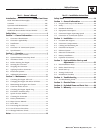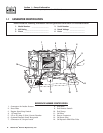
Generac
®
Power Systems, Inc. 7
Section 2 – Operation
PRIMEPACT 50 and 70 (50Hz) Recreational Vehicle Generators
2.1 GENERATOR CONTROL PANEL
The following features are mounted on the generator
control panel (Figure 2.1):
Figure 2.1 – Generator Control Panel
2.1.1 FUEL PRIMER
Before starting a cold engine (if it has not been start-
ed in more than two weeks), you must press this
switch for approximately five seconds to bring fuel
from the tank to the fuel pump. This rocker type
switch springs back into its original position when
you release it.
2.1.2 START/STOP SWITCH
To crank and start the engine, hold this switch in the
START position. Release the switch when the engine
starts. To stop an operating engine, press and hold
the switch in the STOP position until the engine shuts
off. The switch center position is the RUN position.
2.1.3 FUSE
The fuse protects the engine’s DC control circuit
against electrical overload. If the fuse element has
melted open due to overloading, the engine cannot be
cranked. If you must replace the fuse, use only an
identical replacement.
2.1.4 MAIN BREAKER
The main breaker protects the generator’s AC output
circuit against overload and provides a method of
turning OFF the generator’s 230-volt AC output to the
vehicle circuits. These generators have either a 25
Amp, 2-Pole circuit breaker (PP50) or a 30 Amp
2-Pole circuit breaker (PP70).
2.2 OPTIONAL REMOTE
START/STOP PANEL
A remote mounted Start/Stop Panel (Figure 2.2) is
available that allows you to start and stop the gener-
ator engine conveniently from inside the vehicle. The
remote panel includes a Start/Stop switch, hour
meter, generator run lamp and a wire harness.
Figure 2.2 — Optional Remote Panel
(Models 004057 and 004184)
2.3 AUTOMATIC CHOKE
This engine is equipped with an automatic choke that
consists of two main components: a choke solenoid
and prechoke.
2.3.1 CHOKE SOLENOID
During engine cranking (Start/Stop switch at
START), a solid-state choke module signals the
choke solenoid to activate and cycle (choke on/choke
off) until the engine starts. The choke solenoid thus
opens and closes the carburetor choke valve only
when the engine is cranking. When the engine starts,
the choke stops cycling.
2.3.2 PRECHOKE
The choke system also has a temperature-sensitive
metal strip that adjusts choke valve angle according
to ambient temperatures (i.e., in cold ambient tem-
peratures, choke valve closes more). Once the engine
starts, an element heats the temperature-sensitive
strip to a normal operating condition, opening the
choke valve. This may take about three minutes in
cooler weather.
◆
◆
◆
◆
◆
◆


















